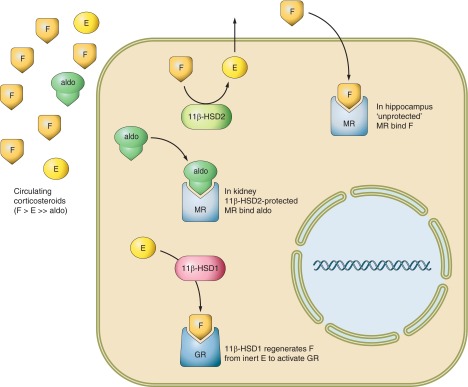Figure 2.

Diagrammatic representation of the reactions catalyzed by 11β-HSDs. The adrenal cortex secretes nanomolar concentrations of cortisol (F) and picomolar concentrations of aldosterone (Aldo) into the circulation. While mineralocorticoid receptors (MR) in the kidney only bind Aldo in vivo, identical MR in the hippocampus are occupied by F in vivo and MR bind F and Aldo with similar affinity in vitro. The solution to this conundrum lies in the collocation of renal MR with 11β-HSD2, which catalyzes the rapid inactivation of cortisol to inert cortisone (E) thus only allowing the nonsubstrate Aldo to access MR. 11β-HSD2 is absent from hippocampus so MR bind F. In tissues such as the liver, adipose, and adult brain, 11β-HSD2 is absent, but there is abundant 11β-HSD1. This catalyzes the reverse reaction in intact cells and organs and thus regenerates active F from inert E, amplifying the local glucocorticoid signal particularly at glucocorticoid receptors (GR). GR have 10-fold lower affinity for F than MR and are thus partially unoccupied by F at physiological concentrations allowing a dynamic range for 11β-HSD1 amplification inside cells to impact on signaling. In contrast, MR are largely occupied by physiological F concentrations where 11β-HSD2 is absent so 11β-HSD1 may make less impact on signaling via MR.
